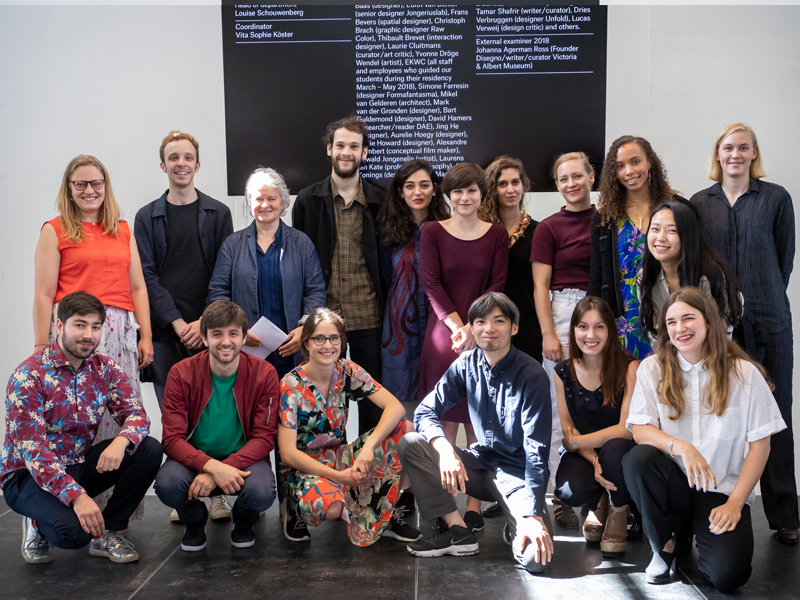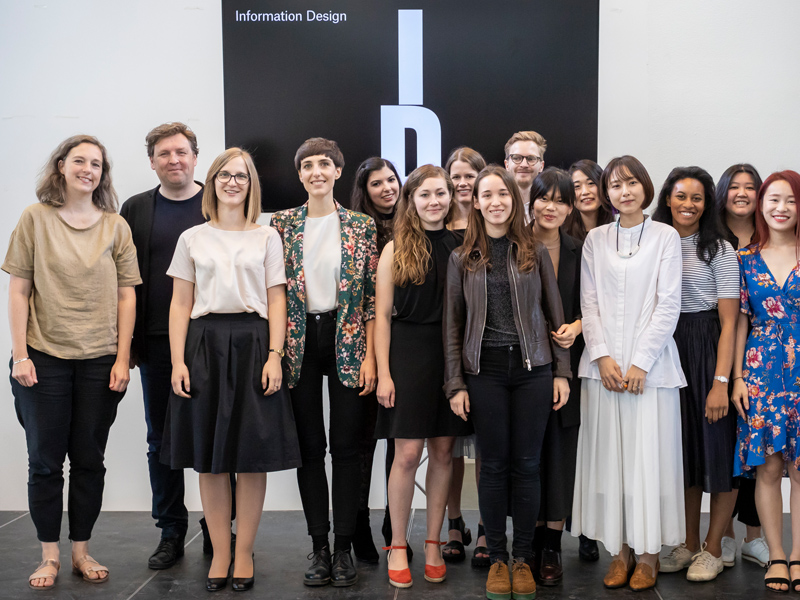

After two days of exams and presentations before a jury of examiners, our Master students graduated Thursday 21 June in front or peers, family, examination committees and department heads, who took the stage to congratulate their students, sharing anecdotes of their challenges, obstacle and final successes.
Joseph Grima, DAE Creative Director spoke of farewells, expressed gratitude, and described the transformation – no, the evolution – of the people graduating. “We are glad to see you go,” he quipped, eliciting soft chuckles from the audience. “This is not the end of learning, but the beginning.” The goal of DAE is to equip its students with tools to carry on their process of learning. And the DAE community continues to keeps its treasured members connected, often inviting alumni back as returning tutors or lecturers.
Grima quoted the American architect/futurist/designer Buckminster Fuller and the voice Fuller heard following his Dark Night of the Soul: “You do not belong to you. You belong to Universe. Your significance will remain forever obscure to you, but you may assume that you are fulfilling your role if you apply yourself to converting your experiences to the highest advantage of others.” It was a turning point not just for Fuller back in 1927, but for the entire design profession. Grima reminded the designers that they make a difference, now that they possess the knowledge to go forth and benefit the world at large. He urged them to make the most of their time beyond DAE, adding that by the time they stop designing at some point far away in the future, design will have little resemblance to how it looks today.
Evolution. People blossom. Design mutates. The world around us shifts and spins. And from the moment we walk through the doors of DAE - whether we be visitor, designer or educator - we are changed by new ideas and ways of seeing things.
Each of the department heads lauded and congratulated each Masters student, and also announced the Cum Laude graduates and Gijs Bakker award nominees as follows:
Contextual Design Department Head Louise Schouwenberg began her speech by fondly sharing a trifecta of hits and misses during the assessment earlier in the week: the lamp that gradually fell down, the cupboard door that would not shut properly again, and the worried concierge who fretted about a leaking bathtub. She retold how the external examiner raised questions on functionality, whereby tutor Tamar Shafrir declared: “In this school, if your object collapses, that’s the one thing you cannot be failed for.” Rewarded Cum Laude and a Gijs Bakker award nomination were two women: were Minji Choi whose project is on the ethics of nature. The garden, being a miniature ode to nature, is the motivation behind her creation of an artificial wild garden juxtaposing the natural and the man-made. Anna Aagaard Jensen's work facilitates, manipulates and dictates human behaviour, such as her chairs designed to invite women to claim space.
Upon visiting the exhibition itself, there was a wide diversity of material, colours and approaches answering the question “what is design?”, at which one could marvel; beautifully handcrafted wooden items, flags, tiny 3D household furniture, weird objects that make you look twice … and even a pneumatic gun installation. Objects that treat a wide gamut of notions ranging from nationality, the inherent integrity of materials and new meanings of ‘play’.
Alice Twemlow took the stage to address her Design Curating and Writing students. She explained that new kinds of curation and writing are needed in order to properly engage with the ever-changing processes, products and implications of design. The word she used was “atomising”: design-as-a-product is no more, now that there is design-as- performance, politics, systems, or tools. “So, the institutions and formats of our media landscape are also in dramatic flux”, which requires a certain agility from the designers and curators that describe them. Alice was proud to reward Yasmin Tri Aryani with Cum Laude and a Gijs Bakker award nomination. Using illustration, Yasmin investigated the design of Indonesian border posts and how and why they integrate elements of traditional architecture. The project was researched in a determined, exemplary manner, uncovering a huge number of primary resources and presented in a fun and approachable way.
Written by Anna Winston, first-year Design Curating & Writing student
For their final exam, the students from the Design Curating and Writing master's programme presented Second Reading, a symposium and collective exhibition at the Van Abbemuseum. The projects covered a wide spectrum of urgent and personal topics, each developed through a thesis essay, a publication designed in collaboration with students from ArtEZ and a curatorial proposal manifested within the exhibition space.
Kirsten Geekie explored the manifestation of design for suicide prevention in the public realm with In Anticipation, while Yasmin Tri Aryani explored the use of architecture in Indonesia's new border posts to establish a national identity that excludes many of the country's ethnic groups in Mapping The Way Home. "Architecture is not about buildings alone, but about conflict, government policy, and multiple conceptions of identity," explained Tri Aryani.
Delany Boutkan offered a provocation for museums with her project The Things Of The Internet, which proposed a re-engagement with images of objects on the internet as distinct entities, while Josh Plough explored the unexpected history of the CD in his curatorial project Errors Aren't Forever as a way of inviting more critical engagement with everyday technologies. 'Curators can challenge the coded curtain that separates technology and humanity,' said Plough.
External examiner Marina Otero, director of research at Het Nieuwe Instituut and Design Academy creative director Joseph Grima both gave their responses to the thesis presentations during the symposium, which was also attended by members of the public and current and future students. The exhibition Second Reading was on show at the Van Abbemuseum until 24th June.
Next to be presented at the graduation ceremony was the Workshop Award, by Andre Wiersma, Workshop Instructor. It was awarded to Robert Johnson, who will receive an extra year in the workshop to continue realising his ideas. “To all the students, stay positive while creating, and enjoy your mistakes! To Rob, thank you for your attitude, positivity, for paying attention to others - and for cleaning up!”
Following a short break, it was Jan Boelen’s turn to speak to the Social Design graduates. “A resilient society requires diverse, connected people.” Think of a forest eco-system, which depends on diversity to make it robust. A forest made up of only one variety of tree would suffer terribly if ravaged by a storm, while the majority of trees would survive if the forest were made up of say, little trees, big trees and bushes. And, though a small number of trees might fall, in such a resilient forest they would have a better chance at regenerating after a savage storm. This sort of thinking is what Jan applies to his department, and the world around us.
Amandine David was awarded Cum Laude and a Gijs Bakker award nomination. Her determined, exhaustive, collaborative investigations of craft and design - hand coiling and 3D printing in this case - ultimately taught her peers to see potential in every failure. And two students were awarded Cum Laude: Gabriel Fontana who used sports as the common denominator and transforms the sports uniform into a multiform - to celebrate fluid, interchangeable identities; and Elisa Otañez who made a political, powerful, empowering design resulting in a vision of an egalitarian public space. Elisa's work asks municipalities to seriously consider the place of women in public spaces, prompting conversation on how female public toilets can (better) be designed and accessed. And another Gijs Bakker award nomination went to Kuang-Yi Ku, who undertook exceptional research and produced a new methodology: a hybrid medicine, which proposes emerging biotechnologies create artificial animal parts for Traditional Chinese Medicine.
In the Social Design exhibition space, visitors were treated to the ambitious, intricate displays of the many tremendous piles of research, often leading to elegant solutions, created by the Cum Laude students and Gijs Bakker award nominees, and their peers.
And finally, Joost Grootens gave his speech and proudly presented the Information Design graduates. “This is the 6th year of this course and before you stand Alumnis 47 through to 59, if you’d care to know.” He then posed the question: “How shall we live together?” He explained that Information Design takes ideas, identities, ideologies, and expresses them using technologies – perhaps even breaking them apart – to examine this question. Through a challenging process, during which the students develop over their time at the academy, this discipline calls for unique individuals who dare to translate all sorts of data and information into digestible, memorable and interesting narratives.
Awarded Cum Laude and a Gijs Bakker award nomination: Mar Ginot Blanco whose instinctive, timely sense of urgency researching our current political reality demonstrates exceptional intuition, and forces us to look at how the EU goes beyond its institutions. She uncovers how contemporary young Europeans are building their own version of community – a new European community – under the auspices of European policies. And a Gijs Bakker award nomination went to Karin Fischnaller, for her almost journalistic, editorial approach to her podcast series between herself (Karin), Karin Anders (an Artificial Intelligence design-bot) and a range of experts, in her investigations into human-bot collaborations.
On the fifth floor the five beautiful tomes by Annika Felder and the intricate Arson Archives by Thomas Stratmann could be admired, with curious traditional Korean music (gugak) playing in the background. Fascinating installations all around with themes ranging from xenophobia, to the Japanese phenomenon of working till one dies (karoshi), to politics of identity and more, kept visitors busily engaged.
The ceremony closed with an invitation from Grima to the Masters students for one last, but new ritual: a Masters group-photo on the stage. Yet another evolution. In the past, each Masters department captured their fellows on graduation day according to discipline. Grima took his chance to morph the tradition, depicting the 2018 Masters students as a unified whole.
All Master students projects will be on show at the Graduation Show 2018 during Dutch Design Week held in October. After 20 successful years within the walls of the DeWitteDame school building on Emmasingel, the 2018 edition of the annual Graduation Show will expand into the former Campina Milk Factory near the Kanaaldijk-Zuid, Eindhoven.